Thermal Field Design of a Large-Sized SiC Using the Resistance Heating PVT Method via Simulations
Abstract
:1. Introduction
2. Experimental
3. Results and Discussion
3.1. Characteristics of Temperature and Flow Field Distribution under a Basic Thermal Field
3.2. Influence of Structural Adjustment on Temperature Uniformity
3.3. Improving Temperature Field Distribution Using Dual Heaters
4. Conclusions
Supplementary Materials
Author Contributions
Funding
Institutional Review Board Statement
Informed Consent Statement
Data Availability Statement
Conflicts of Interest
References
- Powell, A.R.; Sumakeris, J.J.; Khlebnikov, Y.; Paisley, M.J.; Leonard, R.; Deyneka, E.; Gangwal, S.; Ambati, J.; Tsevtkov, V.; Seaman, J.; et al. Bulk Growth of Large Area SiC Crystals. Mater. Sci. Forum 2016, 858, 5–10. [Google Scholar] [CrossRef]
- Dhanaraj, G.; Huang, X.R.; Dudley, M.; Prasad, V.; Ma, R.H. Silicon Carbide Crystals—Part I: Growth and Characterization. In Crystal Growth Technology; William Andrew: Norwich, NY, USA, 2003; pp. 181–232. [Google Scholar]
- Ha, M.; Jeong, S. A Review of the Simulation Studies on the Bulk Growth of Silicon Carbide Single Crystals. J. Korean Ceram. Soc. 2022, 59, 153–179. [Google Scholar] [CrossRef]
- Wei, J.; Li, K.; Li, H.; Hou, D.; Zhang, Y.; Wang, C. Large-Scale Synthesis and Photoluminescence Properties of Hexagonal-Shaped SiC Nanowires. J. Alloys Compd. 2008, 462, 271–274. [Google Scholar] [CrossRef]
- Lebedev, A.A. Deep Level Centers in Silicon Carbide: A Review. Semiconductors 1999, 33, 107–130. [Google Scholar] [CrossRef]
- Tawada, Y.; Tsuge, K.; Kondo, M. Properties and Structure of a-SiC:H for High-Efficiency a-Si Solar Cell. J. Appl. Phys. 1982, 53, 5273–5281. [Google Scholar] [CrossRef]
- Wang, Y.; Gu, P.; Lei, P.; Wang, P.; Fu, J.; Yuan, L. Control of the Growth Quality by Optimizing the Crucible Structure for Growth of Large-Sized SiC Single Crystal. J. Cryst. Growth 2022, 600, 126929. [Google Scholar] [CrossRef]
- Kato, T.; Miura, T.; Nagai, I.; Taniguchi, H.; Kawashima, H.; Ozawa, T.; Arai, K.; Okumura, H. Enlargement Growth of Large 4H-SiC Bulk Single Crystal. Mater. Sci. Forum 2011, 679–680, 3–7. [Google Scholar] [CrossRef]
- Quast, J.; Hansen, D.; Loboda, M.; Manning, I.; Moeggenborg, K.; Mueller, S.; Parfeniuk, C.; Sanchez, E.; Whiteley, C. High Quality 150 mm 4H SiC Wafers for Power Device Production. Mater. Sci. Forum 2015, 821–823, 56–59. [Google Scholar] [CrossRef]
- Choi, J.W.; Kim, J.G.; Jang, B.K.; Ko, S.K.; Kyun, M.O.; Seo, J.D.; Ku, K.R.; Choi, J.M.; Lee, W.J. Modified Hot-Zone Design for Large Diameter 4H-SiC Single Crystal Growth. Mater. Sci. Forum 2019, 963, 18–21. [Google Scholar] [CrossRef]
- Ramakers, S.; Marusczyk, A.; Amsler, M.; Eckl, T.; Mrovec, M.; Hammerschmidt, T.; Drautz, R. Effects of Thermal, Elastic, and Surface Properties On the Stability of SiC Polytypes. Phys. Rev. B 2022, 106, 075201. [Google Scholar] [CrossRef]
- Guo, N.; Pei, Y.; Yuan, W.; Li, Y.; Zhao, S.; Yang, S.; Zhang, Y.; Liu, X. Layered Epitaxial Growth of 3C/4H Silicon Carbide Confined by Surface Micro-Nano Steps. Crystals 2023, 13, 1123. [Google Scholar] [CrossRef]
- Ellefsen, O.M.; Arzig, M.; Steiner, J.; Wellmann, P.; Runde, P. Optimization of the SiC Powder Source Material for Improved Process Conditions during PVT Growth of SiC Boules. Materials 2019, 12, 3272. [Google Scholar] [CrossRef] [PubMed]
- Liu, C.; Chen, X.; Peng, T.; Wang, B.; Wang, W.; Wang, G. Step Flow and Polytype Transformation in Growth of 4H-SiC Crystals. J. Cryst. Growth 2014, 394, 126–131. [Google Scholar] [CrossRef]
- Fan, W.; Qu, H.; Chang, S.I.; Kozak, B.; Shaffer, G.; Galyukov, A.; Lee, W.J. Impacts of Tac Coating On SiC PVT Process Control and Crystal Quality. Mater. Sci. Forum 2019, 963, 22–25. [Google Scholar] [CrossRef]
- Chen, Q.; Zhu, P.; He, M. Simulations of Dislocation Density in Silicon Carbide Crystals Grown by the PVT-Method. J. Cryst. Growth 2020, 531, 125380. [Google Scholar] [CrossRef]
- Steiner, J.; Wellmann, P.J. Impact of Mechanical Stress and Nitrogen Doping on the Defect Distribution in the Initial Stage of the 4H-SiC PVT Growth Process. Materials 2022, 15, 1897. [Google Scholar] [CrossRef]
- Wang, H.; Yu, J.; Hu, G.; Peng, Y.; Xie, X.; Hu, X.; Chen, X.; Xu, X. Micropipes in SiC Single Crystal Observed by Molten KOH Etching. Materials 2021, 14, 5890. [Google Scholar] [CrossRef]
- Liang, L.; Li, S.; Chai, P.; Lan, K.; Yu, R. Molecular Dynamics Simulation of Single-Crystal 4H-SiC Nano Scratching with Different Scratching Directions of the Tool. Crystals 2023, 13, 1044. [Google Scholar] [CrossRef]
- Hayashi, Y.; Mitani, T.; Komatsu, N.; Kato, T.; Okumura, H. Control of Temperature Distribution to Suppress Macro-Defects in Solution Growth of 4H-SiC Crystals. J. Cryst. Growth 2019, 523, 125151. [Google Scholar] [CrossRef]
- Yang, N.; Song, B.; Wang, W.; Li, H. Control of the Temperature Field by Double Induction Coils for Growth of Large-Sized SiC Single Crystals via the Physical Vapor Transport Technique. CrystEngComm 2022, 24, 3475–3480. [Google Scholar] [CrossRef]
- Kawanishi, S.; Shibata, H.; Yoshikawa, T. Contribution of Dislocations in SiC Seed Crystals on the Melt-Back Process in SiC Solution Growth. Materials 2022, 15, 1796. [Google Scholar] [CrossRef]
- Zhang, S.; Fan, G.; Li, T.; Zhao, L. Optimization of Thermal Field of 150 mm SiC Crystal Growth by PVT Method. RSC Adv. 2022, 12, 19936–19945. [Google Scholar] [CrossRef]
- Gao, P.; Xin, J.; Liu, X.; Zheng, Y.; Shi, E. Control of 4H Polytype of SiC Crystals by Moving up the Crucible to Adjust the Temperature Field of the Growth Interface. CrystEngComm 2019, 21, 6964–6968. [Google Scholar] [CrossRef]
- Yang, C.; Liu, G.; Chen, C.; Hou, Y.; Xu, M.; Zhang, Y. Numerical Simulation of Temperature Fields in a Three-Dimensional SiC Crystal Growth Furnace with Axisymmetric and Spiral Coils. Appl. Sci. 2018, 8, 705. [Google Scholar] [CrossRef]
- Luo, H.; Han, X.; Huang, Y.; Yang, D.; Pi, X. Numerical Simulation of a Novel Method for PVT Growth of SiC by Adding a Graphite Block. Crystals 2021, 11, 1581. [Google Scholar] [CrossRef]
- Goldberg, Y.; Levinshtein, M.E.; Rumyantsev, S.L. Properties of Advanced Semiconductor Materials: GaN, AIN, InN, BN, SiC, SiGe; John Wiley: Hoboken, NJ, USA, 2001. [Google Scholar]
- Shaffer, P.T.B. A Review of the Structure of Silicon Carbide. Acta Crystallogr. 2010, B25, 477–488. [Google Scholar] [CrossRef]
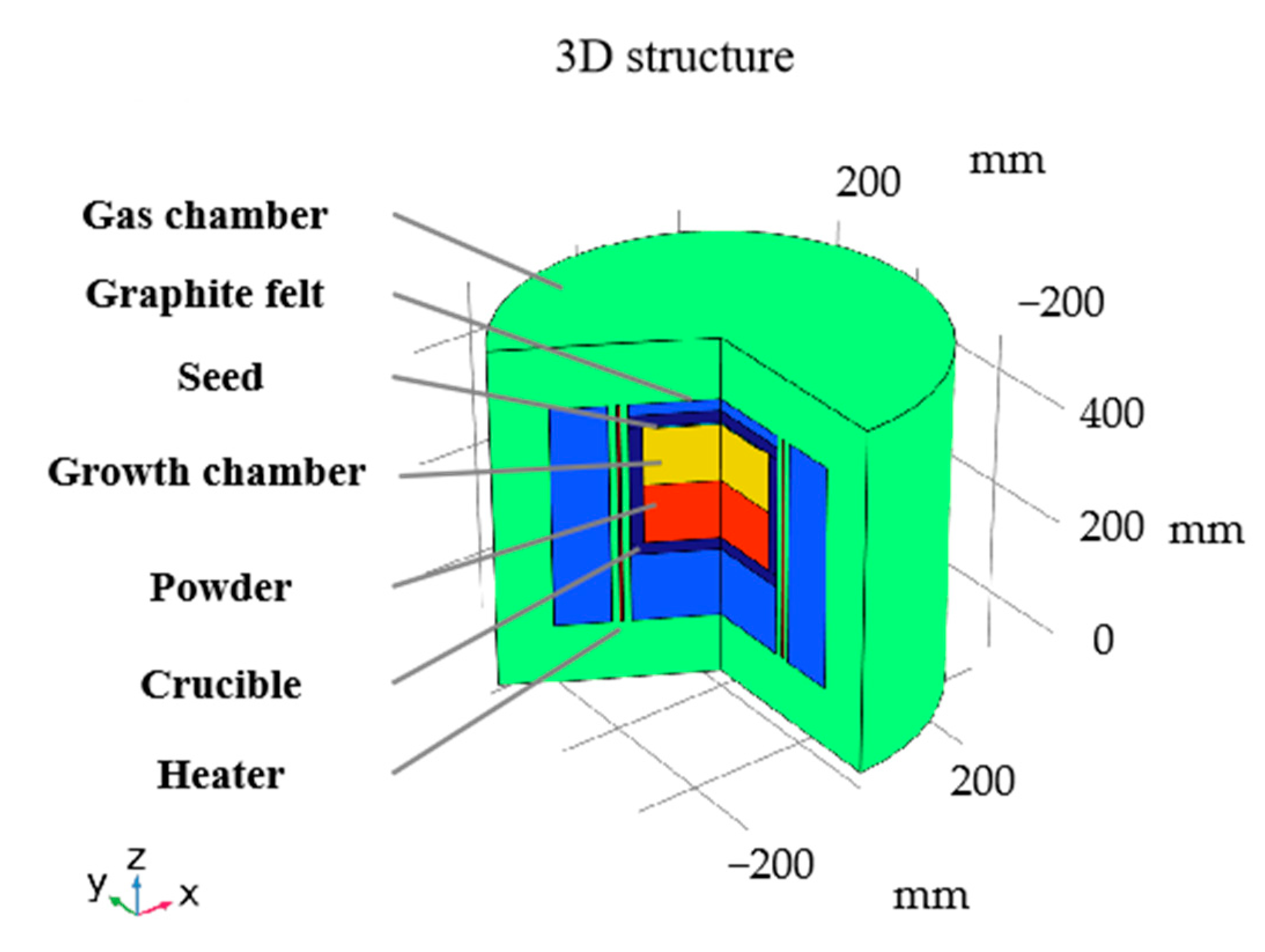
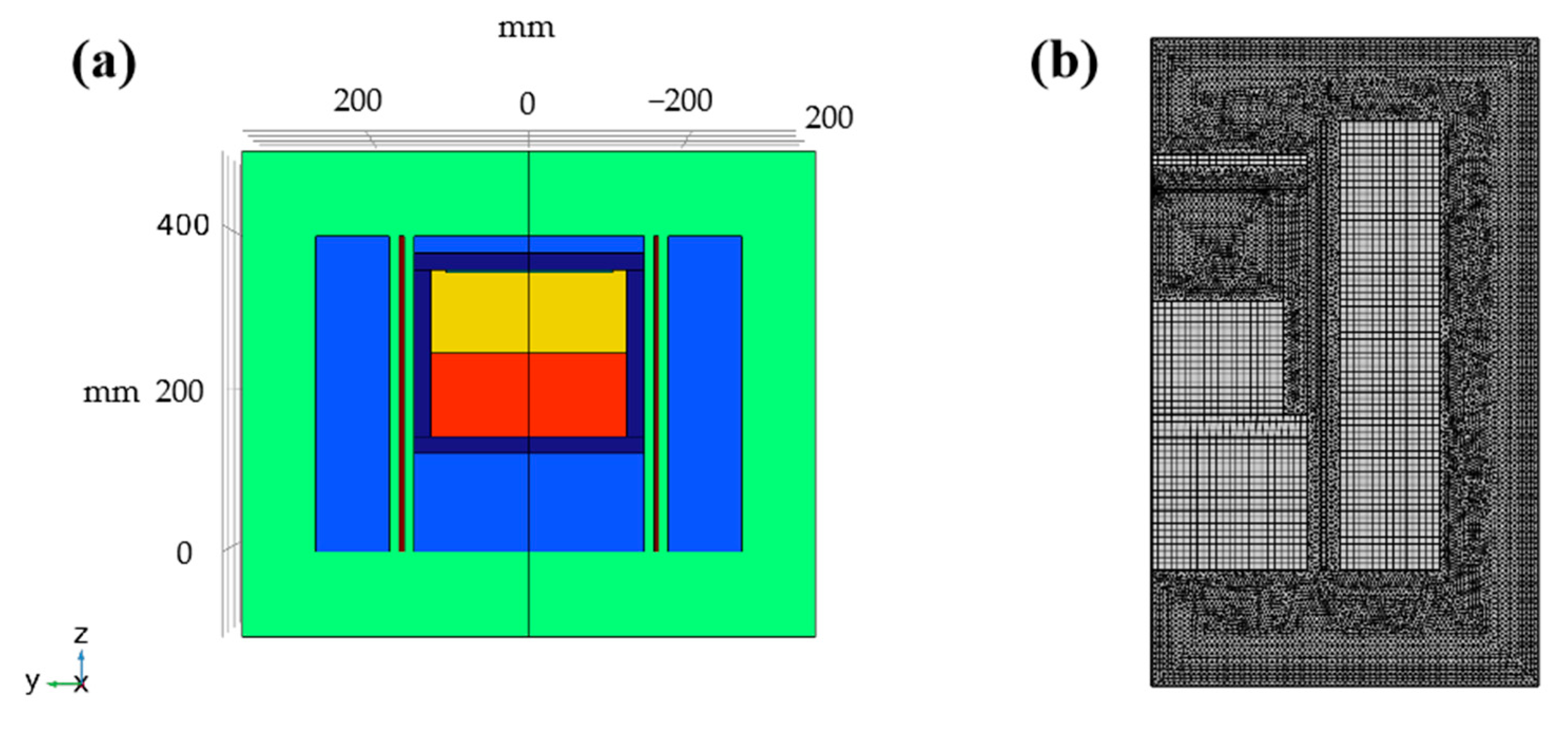


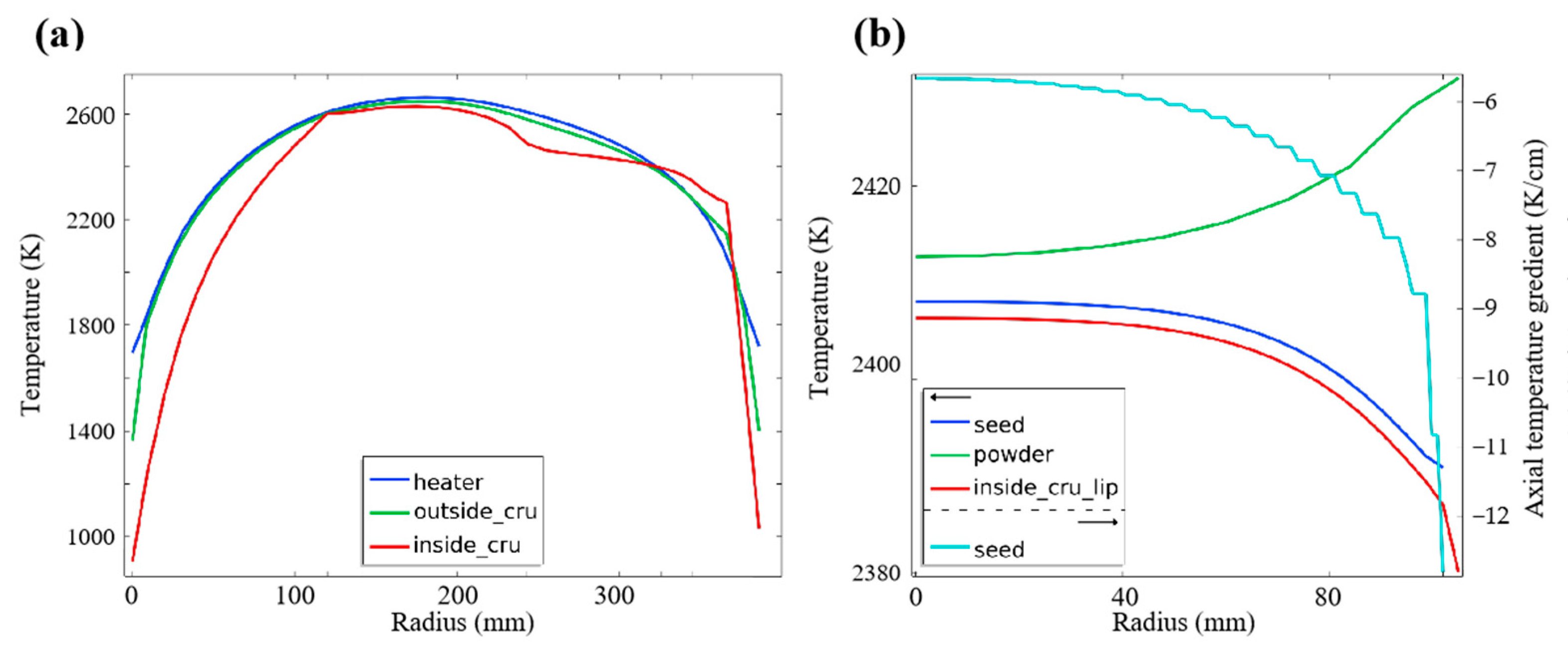


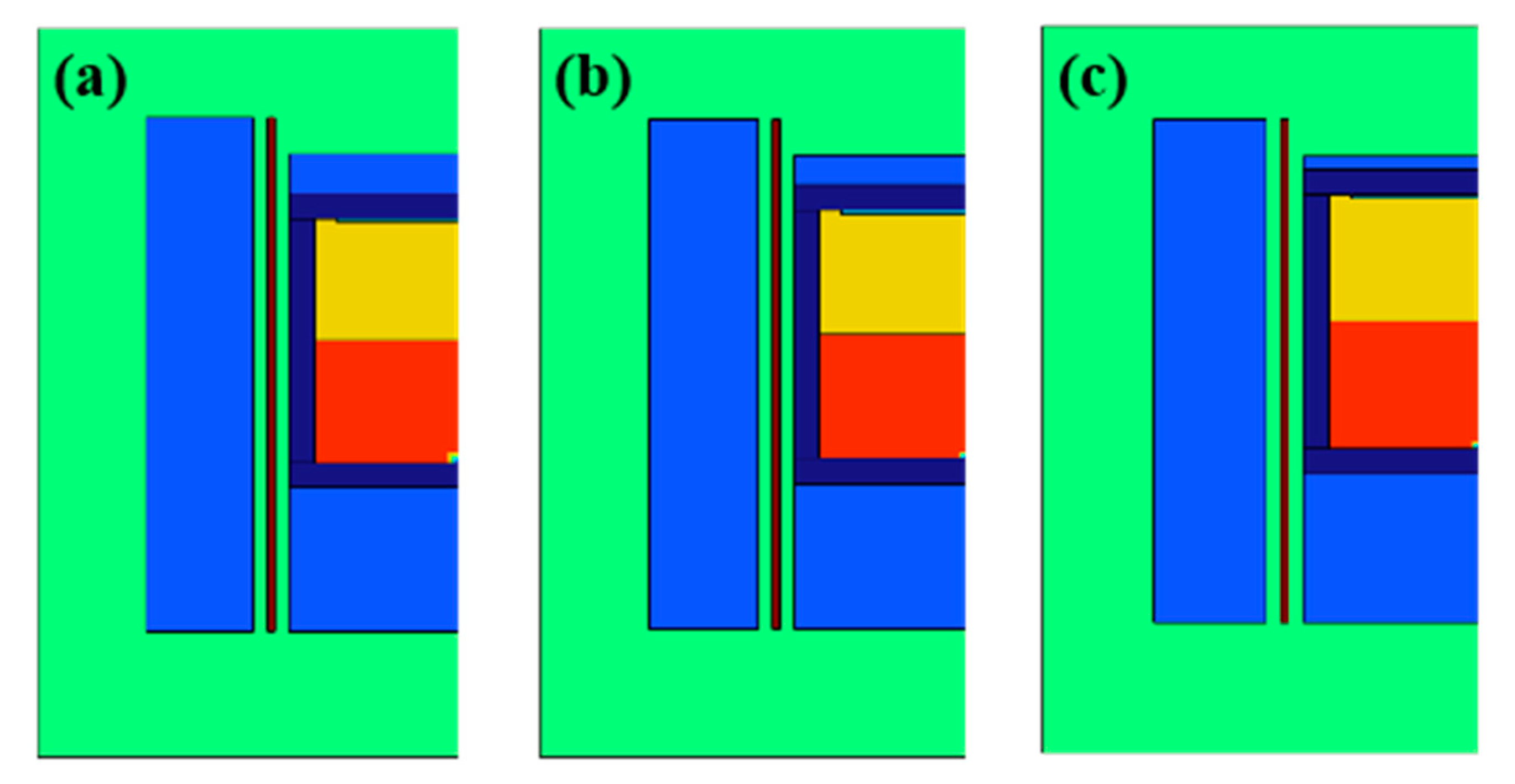

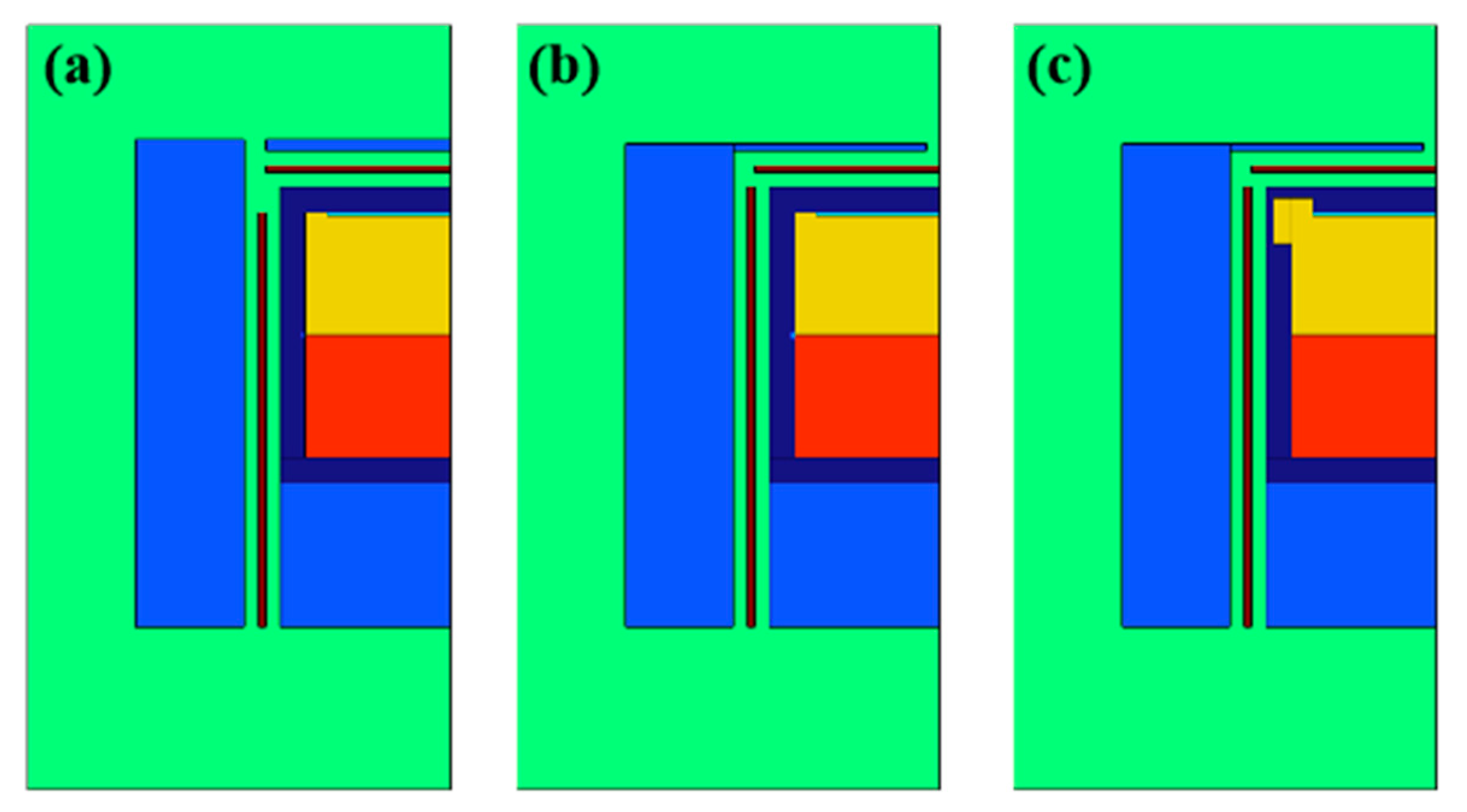

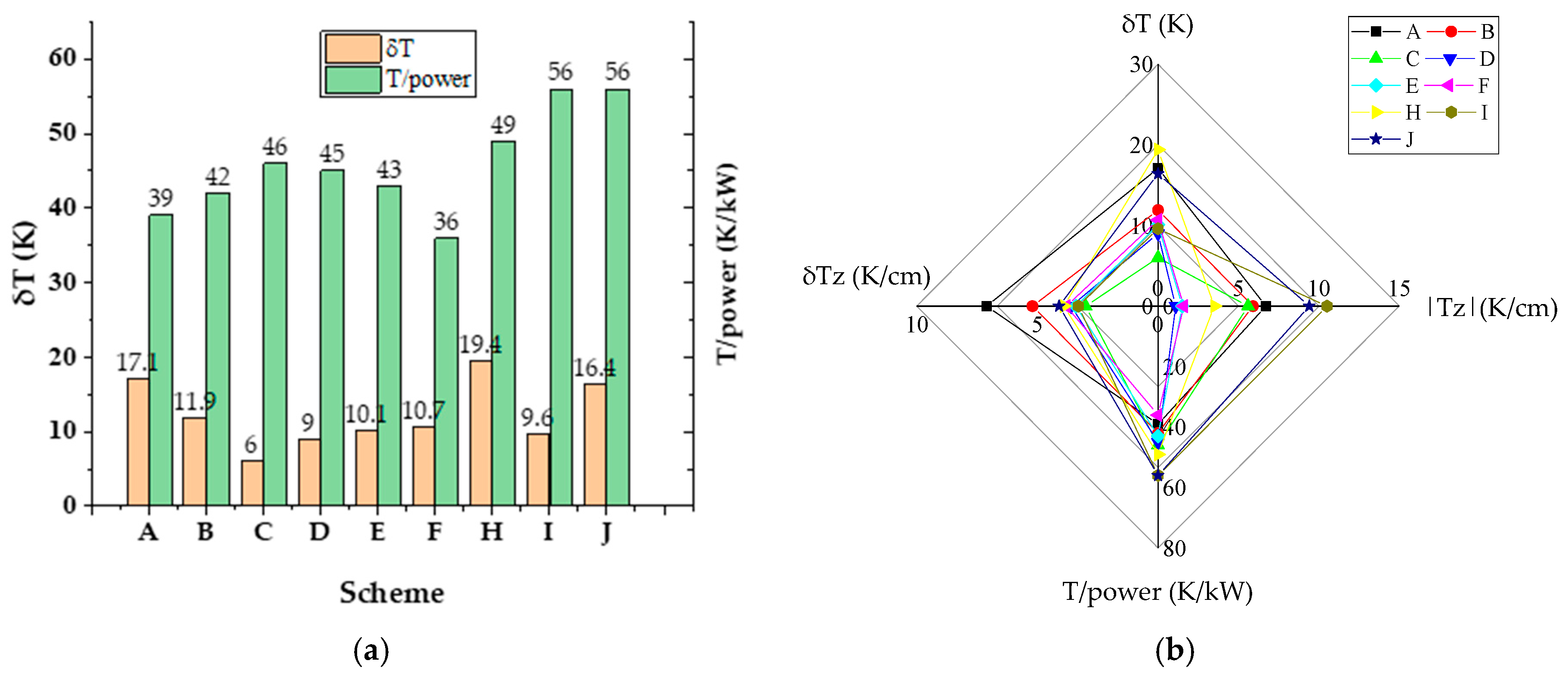
| Structure | Diameter | Height |
|---|---|---|
| Computational domain (mm) | 700 | 600 |
| Thermal field (mm) | 522 | 386 |
| Heater (mm) | 318/306 (internal) | 386 |
| Seed crystal (mm) | 204 | 3 |
| Crucible (mm) | 282 | 246 |
| Growth chamber (mm) | 240 | 102 |
| Categories | Graphite | Graphite Felt | SiC | Argon | SiC Powder |
|---|---|---|---|---|---|
| Conductivity (S/m) | 105 | 100 | 1000 | - | 4 |
| Heat capacity (J/(kg×K)) | 710 | 1000 | 1200 | Figure S1 | 1200 |
| Density (kg/m3) | 1950 | 120 | 3200 | Figure S2 | 1800 |
| Thermal conductivity (W/(m×K)) | 150 × (300[K]/T) | 0.8 | 450 × (300[K]/T)0.75 | Figure S3 | Figure S4 |
| Emissivity | 0.8 | 0.8 | 0.9 | - | 0.8 |
Disclaimer/Publisher’s Note: The statements, opinions and data contained in all publications are solely those of the individual author(s) and contributor(s) and not of MDPI and/or the editor(s). MDPI and/or the editor(s) disclaim responsibility for any injury to people or property resulting from any ideas, methods, instructions or products referred to in the content. |
© 2023 by the authors. Licensee MDPI, Basel, Switzerland. This article is an open access article distributed under the terms and conditions of the Creative Commons Attribution (CC BY) license (https://creativecommons.org/licenses/by/4.0/).
Share and Cite
Zhang, S.; Li, T.; Li, Z.; Sui, J.; Zhao, L.; Chen, G. Thermal Field Design of a Large-Sized SiC Using the Resistance Heating PVT Method via Simulations. Crystals 2023, 13, 1638. https://doi.org/10.3390/cryst13121638
Zhang S, Li T, Li Z, Sui J, Zhao L, Chen G. Thermal Field Design of a Large-Sized SiC Using the Resistance Heating PVT Method via Simulations. Crystals. 2023; 13(12):1638. https://doi.org/10.3390/cryst13121638
Chicago/Turabian StyleZhang, Shengtao, Tie Li, Zhongxue Li, Jiehe Sui, Lili Zhao, and Guanying Chen. 2023. "Thermal Field Design of a Large-Sized SiC Using the Resistance Heating PVT Method via Simulations" Crystals 13, no. 12: 1638. https://doi.org/10.3390/cryst13121638
APA StyleZhang, S., Li, T., Li, Z., Sui, J., Zhao, L., & Chen, G. (2023). Thermal Field Design of a Large-Sized SiC Using the Resistance Heating PVT Method via Simulations. Crystals, 13(12), 1638. https://doi.org/10.3390/cryst13121638








